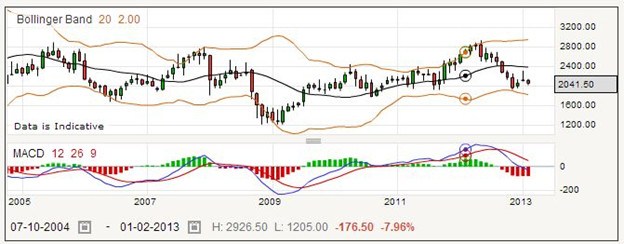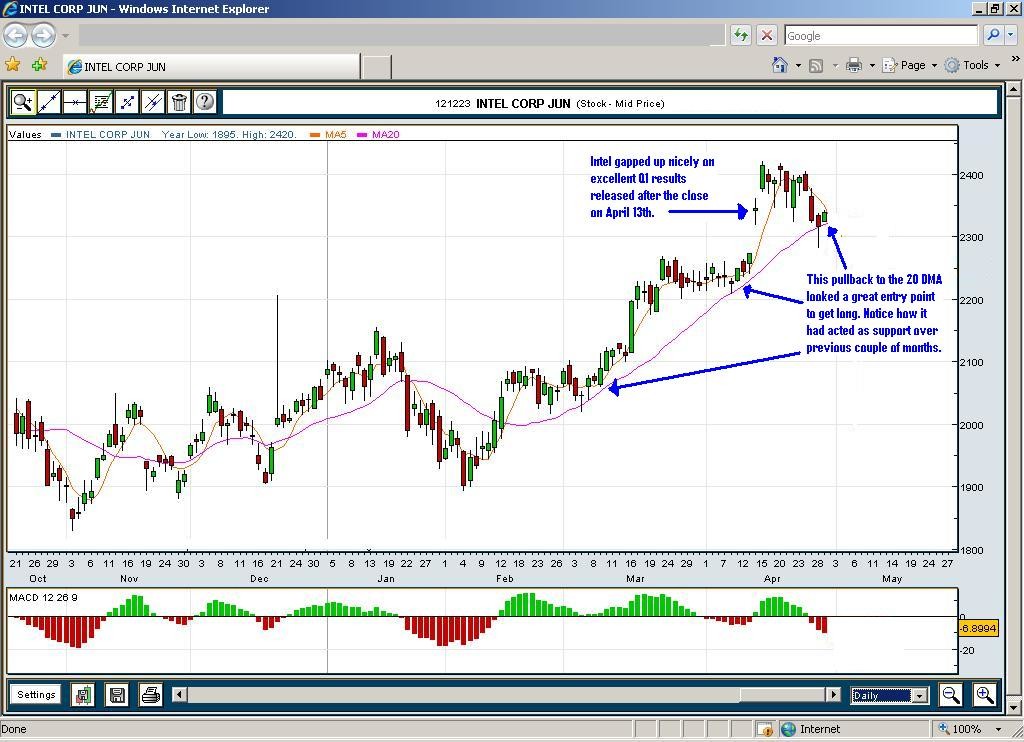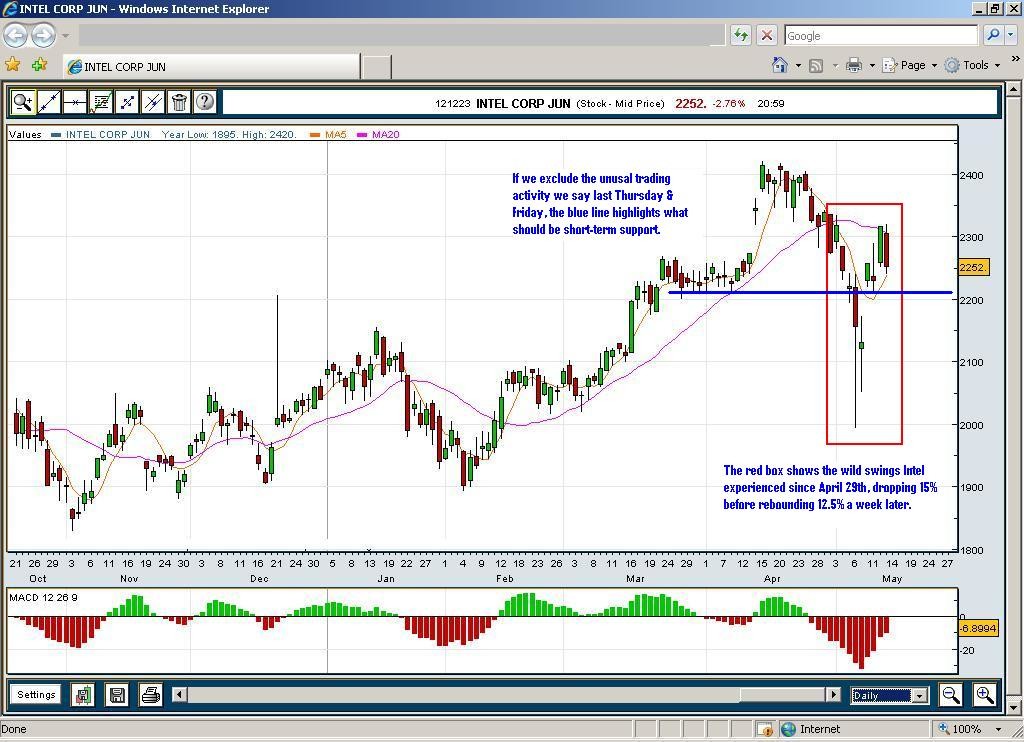Intel Corporation Fundamentals
Intel Corporation is a technology company, and therefore has volatile pricing. Simply looking at the pricing numbers, you can see that over the past year the price has been up 20% and down 20%. For the spread better, these are exciting figures, indicating that there is room for profit, provided you bet in the right direction.
There can be few computer users who have not heard of Intel Corporation. It is after all the world’s largest and highest valued semiconductor chip maker. But as you can see from the yearly price chart above, in recent years it has had its share of ups and downs, making it interesting for spread betting but not so profitable for the long-term investor.
The company is based in California, and was founded in 1968. It was first called NM Electronics, after the initials of its founders, but soon adopted the name Integrated Electronics, shortened to Intel. Its business was focused around random access memory at the start, and this remained a major source of income for some years after the development of microprocessors.
Intel developed the first microprocessors in the 70s, and it was the adoption by IBM of the Intel chip that led to the expansion that we see today. The company expanded at an unprecedented level during the 80s and 90s, helped by the “Intel Inside” advertising program and the Pentium chip. Looking to the future, Intel is increasing its presence in mobile offerings, including smart phones, tablets, and wireless devices.
Over the years there have been many competitors, most notably AMD with which Intel has had some lawsuits. The difficulty for competitors is that IBM has become the standard for personal computing, with Apple presenting the only other widespread standard, so it is natural for the competition to try and emulate Intel’s devices, while skirting around copyright issues. Against this, there are findings such as that by the European Commission relating to antitrust rules, accusing Intel of shutting out reasonable competition.
Despite the ups and downs in its share price, Intel still has by far the largest market share in PC microprocessors. By various standards, it has between 70% and 80% of the PC market. Nonetheless, as this is already priced into the shares, any fluctuations from this level impact the market price.
Intel Corporation Shares Trading Example 1: Intel Corporation Rolling Daily
Intel Corporation is a great US stock for spread betters, in that it is volatile and provides plenty of opportunities for making a profit, either up or down. Of course, this also means that there is risk, and you should be familiar with the ways of mitigating your losses before betting. Let’s suppose that the current price for a daily rolling bet is 2472 – 2476.
If you think that the price is going up, you could place a long bet for £5 per point at the buying price of 2476. Should you be proved correct, you might decide to cash in and take your profit when the price goes up to 2613 – 2617. In this case your starting price was 2476 and your closing price is 2613. The difference between these is your gain in points, which is 137 points. Multiplying by your stake, you would have won £685.
Of course sometimes the price will go in the opposite direction to the one that you pick. Perhaps in this case the price drops to 2387 – 2391, and you’re forced to close your bet and cut your losses. Your starting price was 2476, and the bet closed at 2387. 2476 minus 2387 is 89 points, which times £5 gives you a total loss of £445.
Many spread betters like to use a stop loss order, which is usually placed at the time the bet is opened. This means that your spread betting provider will close your bet if it gets to a specified level of loss against you, and saves you having to watch the markets to close the trade manually. If you had used this, you might find that the trade closed earlier, when the quote was 2407 – 2411. In this case, your starting price was 2476 and your closing price 2407, a difference of 69 points, so this loss would have cost you £345.
Intel Corporation Shares Trading Example 2: Intel Corporation Rolling Daily
The size of a company does not ensure that it will always increase in value, and Intel is an example of this. Therefore you should be careful to adopt and test your trading strategy on its share price before staking any money. Say that you decide that the price will go up, you might be tempted to place a long bet on the stock, which is currently quoted at 2040 – 2044 for a daily rolling bet. Perhaps you would stake £1.50 per point.
With a long daily rolling bet, your spread betting provider may make a small charge each evening when the bet is rolled over. Usually this is not significant compared with the price fluctuations. Suppose the price goes up to 2526 – 2530, and you close your position to collect your winnings. Your long bet opened at 2044, and it closed at the selling price of 2526. That means you have gained 2526 minus 2044 points, or 482 points. For your stake of £1.50 per point, that amounts to a win of £723.
It might be that the stock price falls after you place your bet, and you need to take a view of your position. You should never allow your losses to become too great, but accept them and close the bet. If the price drops to 1797 – 1801 and you close the trade, you would have lost 2044 less 1797 points, which is 247 points. For a stake of £1.50 per point, your losses would amount to £370.50.
If you had chosen to take out a stop loss order when you placed your bet, your spread betting provider would close the bet for you when it reached a preset level, perhaps saving you some money. Say in this case the bet closed when the quote was 1894.2 – 1898.2. You would have lost the difference between 2044 and 1894.2, the closing price. With 149.8 points lost, this would have cost you £224.70.
Intel Corporation Futures Based Betting Example 1
For a longer view on the market, you may consider betting on a quarterly style bet. This has the advantage that you do not have any charges made to your account while the bet is open, although usually there is a larger spread imposed. In this case, the far quarter is currently quoted as 2038 – 2062. Perhaps you would place a long bet for £1 per point at the buying price of 2062.
If things go well, you might find that the quote goes up to 2767 – 2791, and you can close the bet to collect your winnings. Your bet opened at a price of 2062. The closing price was 2767, which means you have gained 705 points. With a stake of £1 per point, you can easily see that you have won £705.
It is important to remember that even with a futures style bet, you are able to close the trade any time you want to, so if the price fell quickly after you had opened the position you could cut your losses. Say the price drops to 1795 – 1819 a week or two after you place the trade, you might choose to close the spread bet and accept your loss. Your bet opened as a price of 2062, as before, but this time it closed at 1795. 2062 minus 1795 is 267 points. Therefore this time you would have lost 267 times £1, your stake, which amounts to £267.
Many traders decide to use a stop loss order, which is usually placed when you open your bet, as this means any losing trade will be closed by your spread betting provider, whether or not you are watching the markets. With a stop loss order in this case, you might find the trade closed when the quote is 1892.2 – 1916.2, so the closing price would be 1892.2. The difference between 2062 and 1892.2 is 169.8 points, so your losses would be kept down to £169.80.
Intel Corporation Futures Based Betting Example 2
A futures based bet typically has a larger spread between the buying and selling prices than a rolling daily bet. However, there are no further charges made to your account while you hold the bet open, so provided you intend to close the bet before the expiry date, it can work out cheaper. The current pricing for Intel Corporation for the far quarter is 2469 – 2486.
Say you believe that Intel will go down over the next few months, you might place a sell bet for £3 per point. If you are proved correct, you could consider closing the bet and collect your winnings if the price goes down to 2236 – 2252. Your bet was placed at the selling price of 2469, and it closed at the buying price of 2252. This is a difference of 217 points. As you bet £3 per point, this means you would have won £651.
On the other hand, you might find that the price continued to go up, until it reached a level where you felt that you had to close the trade to mitigate your loss. It might go up to 2653 – 2671 before you closed your bet. The starting price was the same, at 2469, but your bet closed this time at 2671. The difference between these is 202 points, which for your given stake would cost you £606.
As an alternative, you might consider placing a stop loss order when you take out your bet. This is a popular way to trade, as it saves you having to keep an eye on the markets all the time – your spread trading provider takes care of closing a losing trade for you. If you had done this, you might find that your spread bet was closed at 2572 – 2590. Your loss would be reduced, as 2590 minus 2469 is 121 points. Multiplying by £3, your original stake, means that this bet would have cost you £363.
Trade Example
Before I get into the specifics of Intel’s result I thought I’d share a recent trade that didn’t quite go to plan. At one point I remember at the time thinking the chart was setting up really nice for a good entry price. This was back on 29th April, 2 weeks earlier the company had reported amazing earnings that smashed analyst estimates (revenues of $10.3 billion, analyst were expecting $9.8 billion, EPS of 43 cents a share, analysts were expecting 38 cents a share). Profits of $2.4 billion were 288% higher than the $647m reported in Q1 2009! No surprise then that the stock gapped up over 3% on these result and pushed another 3% higher over the next few days before it started to fall back a bit. Having missed the initial jump up I was patiently waiting for another opportunity to go long and felt I had it on April 29th when after a big pull-back the day before Intel closed back above its 20 day moving average which had acted as support since early February (see the chart below which shows Intel on 29th April). I also liked how, despite the previous days sell-off, the stock had still managed to close above the gap-up which came the day after the results were announced. I saw this as an ideal opportunity to get long and watch Intel push on to new highs for the year.
Of course in trading things don’t always work to plan and a 3% sell-off the next day saw me promptly stopped out of my position (see 2nd chart below which shows Intel yesterday). Thankfully a tight stop 50 pts below meant my loss was a relatively small one. While never happy with a losing trade on reflection I am still ok with the trade I put on, there was a lot going for it and I had properly defined my risk. Given a similar setup today on Intel or some other stock I was bullish on I’d probably put the same trade on again. Since then the stock first sold off dramatically, all the way down to $19 during last Thursday crash, albeit only for a few minutes, before recovering most of its losses to now stand at $22.50, just about where it was before it announced its Q1 results.
New Product Cycle And Increased Corporate Spending Is Good News For Intel
So what to do now. Well longer term I’m bullish on Intel but really this is just my opinion. There are a lot of factors driving the most recent set of results which I’d expect to see continue for the rest of this year and into next including:
- Stronger corporate spending driven by the need for hardware and software upgrades after a few yrs of limited spending as the recession forced companies to cut back all non-essential spending.
- Stronger consumer spending on laptops driven by the release of Windows 7 and Windows 8
- The move towards cloud computing is creating a new area of demand
- A new wave of netbooks, tablet PCs and mobile devices are furthering the demand for Intel’s chips.





Join the discussion